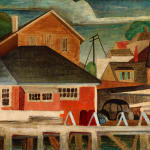Blanche Lazzell 1878-1956
Framed dims: 31 x 34 3/4 inches
Inscribed on verso: WPA 1936 / Lumber Wharf 24 x 28 / Blanche Lazzell / Provincetown, Mass
A remarkably talented, versatile, and innovative artist, Blanche Lazzell experimented with Post-Impressionism, Pointillism, Cubism, and abstraction in her paintings and prints, and was among the earliest modernists in the United States. Her boldly designed and lushly painted oils and her vibrantly colored and exquisitely executed color woodblocks helped establish her fame as a creative force in modern American art during the first decades of the twentieth century.
Lazzell was born in Morgantown, West Virginia. At an early age she decided that her education was more important than a conventional married life. While at West Virginia University she boldly expressed: “I am going to be an independent maiden lady. And I will show people I can be as happy as anyone.” Lazzell’s innate sense of self-reliance served her well and gave her the freedom and confidence she needed to study art. In 1907-8 she trained at the Art Students League in New York with William Merritt Chase. In 1912 she embarked on a summer trip to Europe with a group of women. In the fall of that year she returned to Paris where she enrolled at the Académie Julian and Académie Moderne. Her study at the Académie Moderne was best suited to her artistic style and sensibility. There, the landscapes of Paul Cézanne were an important teaching source and influence, which Lazzell would carry with her after her return to the States.
After her study in Paris, Lazzell went back and forth from Morgantown, West Virginia to Provincetown, Massachusetts, where she spent a few summers studying with Charles Webster Hawthorne. She was also introduced to color woodblock printing there. Lazzell was a naturally gifted printmaker, and her prints won consistent critical acclaim.
Lazzell gravitated toward a modernist artistic style. She first visited Provincetown in 1915, when the town was bustling with expatriate European artists and writers seeking to escape the First World War. Lazzell’s affiliation with the Provincetown Printers, a group of exceptional women printmakers, brought her into the inner circle of American modernists living and working in the village.
In the summer of 1916, Lazzell studied with Oliver Newberry Chaffee, who taught her the method of white line color woodcuts. Lazzell soon became one of the leading exponents of the color woodblock print in America, creating 138 woodblocks between 1916 and 1965. She was prolific in the 1920s and created prints of semi-abstract still lifes and landscapes that reveal her mastery of composition, color, and skillful technique. She developed a favored format of nearly square blocks about 12 x 14 inches. The concepts of synthetic cubism, which were essential to her artistic vision, are apparent in all of her prints. The landscapes generally present spatial illusions, while the floral still lifes seem flat and hover on the cusp of pure abstraction.
In 1923 Lazzell returned to Europe and studied with Albert Gleizes, André Lhote, and Fernand Lége and embarked on an intensive study of Cubism. Her strong interest in structure, geometry and vibrant color became the hallmark of her mature painting style.
From 1934 to 1939 during the Great Depression, Lazzell worked under two New Deal organizations, the Public Works of Art Project (PWAP) and the Works Progress Administration’s Federal Art Project (WPA/FAP). Although she was always frugal and spare, Lazzell needed the work to survive the privation of the Depression. She made paintings and prints for PWAP, and the 105 color prints for WPA/FAP. Lumber Wharf of 1936 is an oil painting she created in advance of a print of the same composition for WPA/FAP. The painting demonstrates the best of Lazzell’s artistic style, the simple geometric shapes of the buildings, intriguing angles, and flattened picture plane make the painting simultaneously modern and charming. Her work from 1936 was particularly popular at the WPA/FAP, and she welcomed the praise, writing “it’s lovely the way my things are appreciated here.” The composition of the Lumber Wharf also mirrors the style of the white-line prints she was most famous for even during her lifetime. What makes Lazzell’s work for the WPA/FAP stand out is the way she brought modernity to artistically conservative New England through her modernist vision of socially conscious subject matter.
Provenance
Private collection, Maine, circa 1945;Private collection, Maine (by descent from the above, their son);
Acquired from the above, until 2024;
Shannon's, Milford, CT, Fine Art Auction, October 24, 2024, lot 93



